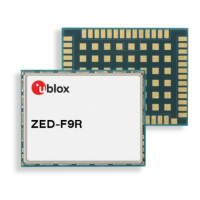ZED-F9R-Integration manual
For more information see the NEO-D9C integration manual and applicable interface description.
3.1.10 Navigation configuration
This section presents various configuration options related to the navigation engine. These options
can be configured through CFG-NAVSPG-* configuration keys.
3.1.10.1 Platform settings
u-blox receivers support different dynamic platform models (see the table below) to adjust the
navigation engine to the expected application environment. These platform settings can be
changed dynamically without performing a power cycle or reset. The settings improve the receiver's
interpretation of the measurements and thus provide a more accurate position output. Setting the
receiver to an unsuitable platform model for the given application environment is likely to result in
a loss of receiver performance and position accuracy.
The dynamic platform model can be configured through the CFG-NAVSPG-DYNMODEL
configuration item. The supported dynamic platform models and their details can be seen in Table
8 and Table 9 below.
Platform Description
Portable Applications with low acceleration, e.g. portable devices. Suitable for most situations.
Stationary Used in timing applications (antenna must be stationary) or other stationary applications.
Velocity restricted to 0 m/s. Zero dynamics assumed.
Pedestrian Applications with low acceleration and speed, e.g. how a pedestrian would move. Low
acceleration assumed.
Automotive (default) Used for applications with equivalent dynamics to those of a passenger car. Low vertical
acceleration assumed.
At sea Recommended for applications at sea, with zero vertical velocity. Zero vertical velocity assumed.
Sea level assumed.
Airborne <1g Used for applications with a higher dynamic range and greater vertical acceleration than a
passenger car. No 2D position fixes supported.
Airborne <2g Recommended for typical airborne environments. No 2D position fixes supported.
Airborne <4g Only recommended for extremely dynamic environments. No 2D position fixes supported.
Wrist Only recommended for wrist-worn applications. Receiver will filter out arm motion.
Robotic lawn mower Used for applications with dynamics equivalent to those of a robotic lawn mower. Low horizontal
speed assumed.
E-scooter Used for applications with dynamics equivalent to those of an e-scooter. Low vertical
acceleration assumed.
Table 8: Dynamic platform models
Platform Max altitude [m] Max horizontal
velocity [m/s]
Max vertical velocity
[m/s]
Sanity check type Max
position
deviation
Portable 12000 310 50 Altitude and velocity Medium
Stationary 9000 10 6 Altitude and velocity Small
Pedestrian 9000 30 20 Altitude and velocity Small
Automotive 6000 100 15 Altitude and velocity Medium
At sea 500 25 5 Altitude and velocity Medium
Airborne <1g 80000 100 6400 Altitude Large
Airborne <2g 80000 250 10000 Altitude Large
Airborne <4g 80000 500 20000 Altitude Large
Wrist 9000 30 20 Altitude and velocity Medium
UBX-20039643 - R06
3 Receiver functionality Page 18 of 119
C1-Public

